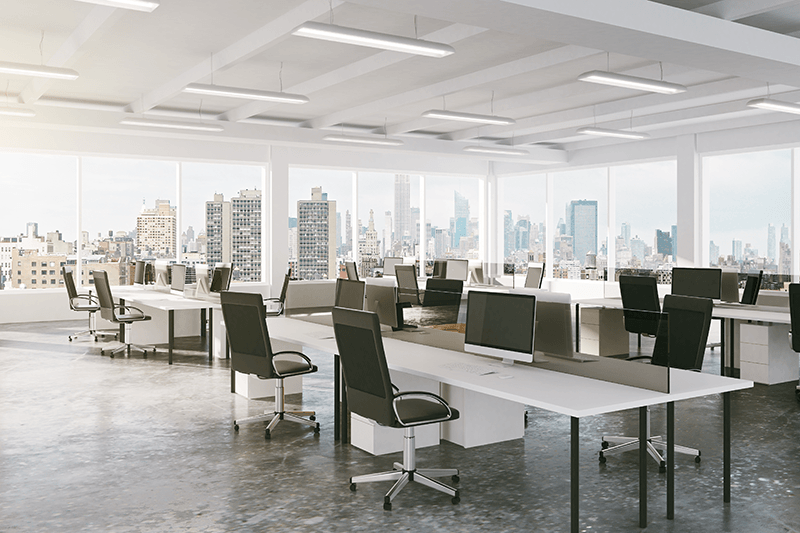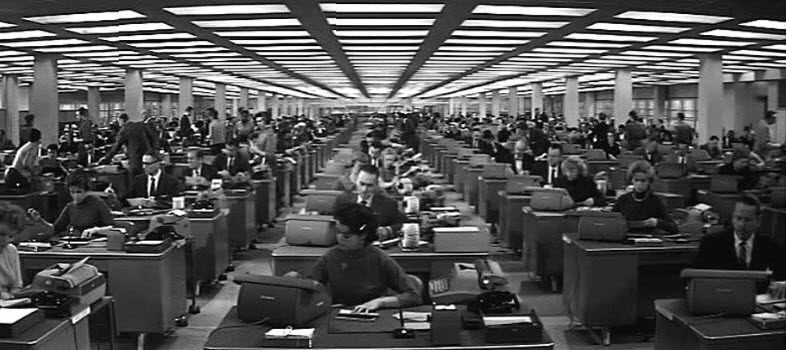With the rapid adoption of open workspaces, the office environment is changing faster than ever before. While many employers (and employees) welcome new open office designs that encourage spontaneous collaboration in a stimulating work environment, other employees find there is a downside: distractions caused by increased noise and reduced privacy in open workspaces can make it harder to concentrate and think.
From the Bullpen to the Action Office to today’s Open Workspace — are work environments evolving faster than we can adapt?
What’s the real cause for all these changes in office design?
If we had to guess, we’d probably say it boils down to the natural desire for business to want to grow and become more profitable. To achieve this, businesses invest in the most current technologies available to help their employees become more productive.
As we look back in time, we can easily see how each generation’s business technology had an influence on office design:
- In the early 1900s, office design had to change to incorporate a succession of new devices, as office communications moved from the telegraph to the ticker tape and the telephone.
- The post World War II era saw another shift. While many office workers were employed typing out documents in secretarial ‘bullpens’, the mainframe computer was making inroads into business offices.
- By the 1960s, collecting, managing, interpreting and distributing information was emerging as a full-fledged business unto itself — becoming as important as manufacturing goods in a factory.
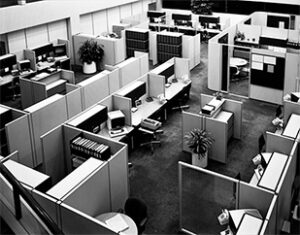
In response to these changes, designer Robert Probst of Herman Miller created an influential line of furniture that lives with us to this day, the Action Office, a concept that many now derisively refer to as office cubicles, cubes or cube farms.
(To learn more about the history of cubicles and ‘cube farms’, we recommend the book Cubed: A Secret History of the Workplace by Nikal Saval.)
While we make fun of cubes today, the original concept was a huge step forward – offering far more privacy and quiet compared to working in the bullpen-style office that preceded it.
Cubicles, as it turns out, were the right design at the right time. As computer technology during the late 1970s and early 1980s got smaller and smaller, cubical designs were ideally suited to be the ‘home’ for the next generation of business technology, the ubiquitous PC desktop computer and monitor combination found on almost every office worker’s desk.
Work Anywhere Technology Leads to Open Workplaces

But technology marches on. Wireless technology and even more powerful devices mean today’s office workers can ‘work from anywhere’ — from the coffee shop to the airport and mid-flight on the plane.
In this new, more mobile world, some high-tech companies began to ask the question… “if an increasing number of our employees are working on the go and outside the office, why should we pay for dedicated cubicles and desktop PCs if they rarely use them?”
And so in the 1990s, high-tech companies, like design software giant Autodesk, began issuing employees notebook computers instead of desktop machines. Employees who traveled extensively or worked remotely would no longer get a dedicated cubicle. Instead, they would be provided temporary ‘hotel’ space at the office – allowing them to plug-in and do their work when they did come into the office. To provide space for collaboration, an ample number of conference rooms were made available to conduct impromptu meetings.
Startup culture took to this approach and made it universal. No more dedicated offices, just open workspaces that looked like a coffee shop — paired with airy, glass-walled conference rooms for meetings.
Has this approach been successful? From all outward appearances, the answer is yes. High-growth companies like Facebook, Google, Twitter, Pinterest all use the open workspace plan, and there is no denying their success.
Around the world, other companies, in other industries, have been trying to unlock the secrets of these phenomenally successful high-tech companies. Is the open workspace part of the ‘secret sauce’ of their success? Does it lead to, as many proponents advocate, an environment where spontaneous collaboration and innovation occurs by design?
More and more employers worldwide are going to find out.
According to the results of the British Council for Offices survey What Workers Want 2016 by Steven Lang of Savills PLC, the number of British workers in traditional office environments has dropped to 77%, while open offices have doubled to 18% in just the last three years. (Rounding out the survey, 3% worked remotely, and 2% worked in business incubators.)
What Advantages do Open Workspaces Offer Employers?
Let’s take a look at the pros and cons of working in an open workspace, both from the employer and employee point of view.
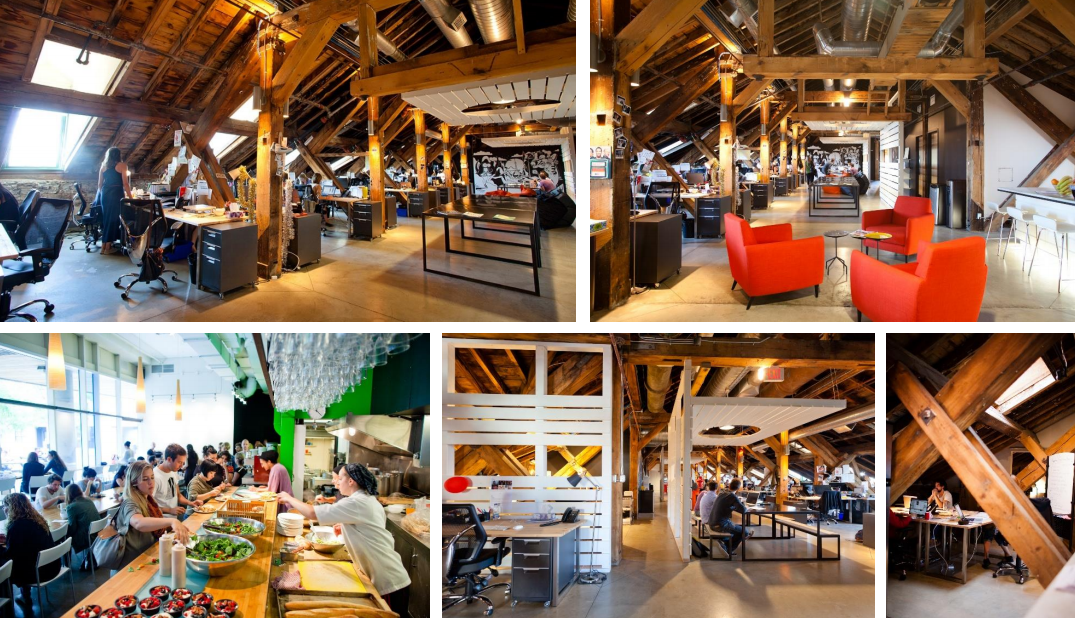
First up, the employer’s view. Here are some of the key benefits employers seek to achieve by implementing an open workspace plan:
Spontaneous Collaboration
It’s true. Many of the great discoveries and innovations can trace their roots back to serendipitous meetings between individuals. With that in mind, most open workspaces are built around elements designed to encourage impromptu encounters. Examples include convenient casual seating areas and informal work tables that allow you to meet face-to-face with your fellow project team members — all in hopes of fostering fateful spontaneous ideas that spur innovation.
Deliver Projects Faster
Whether you use business school nomenclature like first mover advantage, or colloquial expressions like go big or go home, there’s no question that being first in the market with a product or service is more important than ever before. An implicit goal of open workspace design is to help employees to deliver projects faster; in fact, some business leaders consider the open workspace to be a physical manifestation of the rapid software development methodology known as Agile.
Attracting Millennial Talent
An increasing challenge for employers is attracting the best and brightest talent. As it turns out, office design plays an increasingly important role in determining where the Millennial generation wants to work — they are attracted to a contemporary warehouse-style and industrial-looking offices — and open workspace design concepts appeal to them.
Increase Space Flexibility, Reduce Real Estate Costs
The open workspace design concept can reduce square footage requirements by as much as 50% compared to traditional cubicle layouts. This can provide employers a significant saving in real estate leasing costs. Another benefit is flexibility: there is less need to reconfigure dedicated office space each time an employee comes on board or departs the organization.
Flatten Management Structure, Knock Down Silos
Employers also see open workspace offices as an opportunity to flatten their management structure — managers working face-to-face with their direct reports can be less intimidating and distant, which in turn can increase the level of trust and openness.
Knocking down silos in an area within a company that tend to be isolated from other departments is another goal many employers have in mind when moving to an open workspace environment. When members of different departments work together face-to-face, there should be less of a ‘toss it over the wall’ mentality that can occur when company departments are physically separated from one each other.
What Advantages Do Employees See in Open Workspace Designs?
Employees that are satisfied with open workplace offices generally see the same advantages that their employers do:
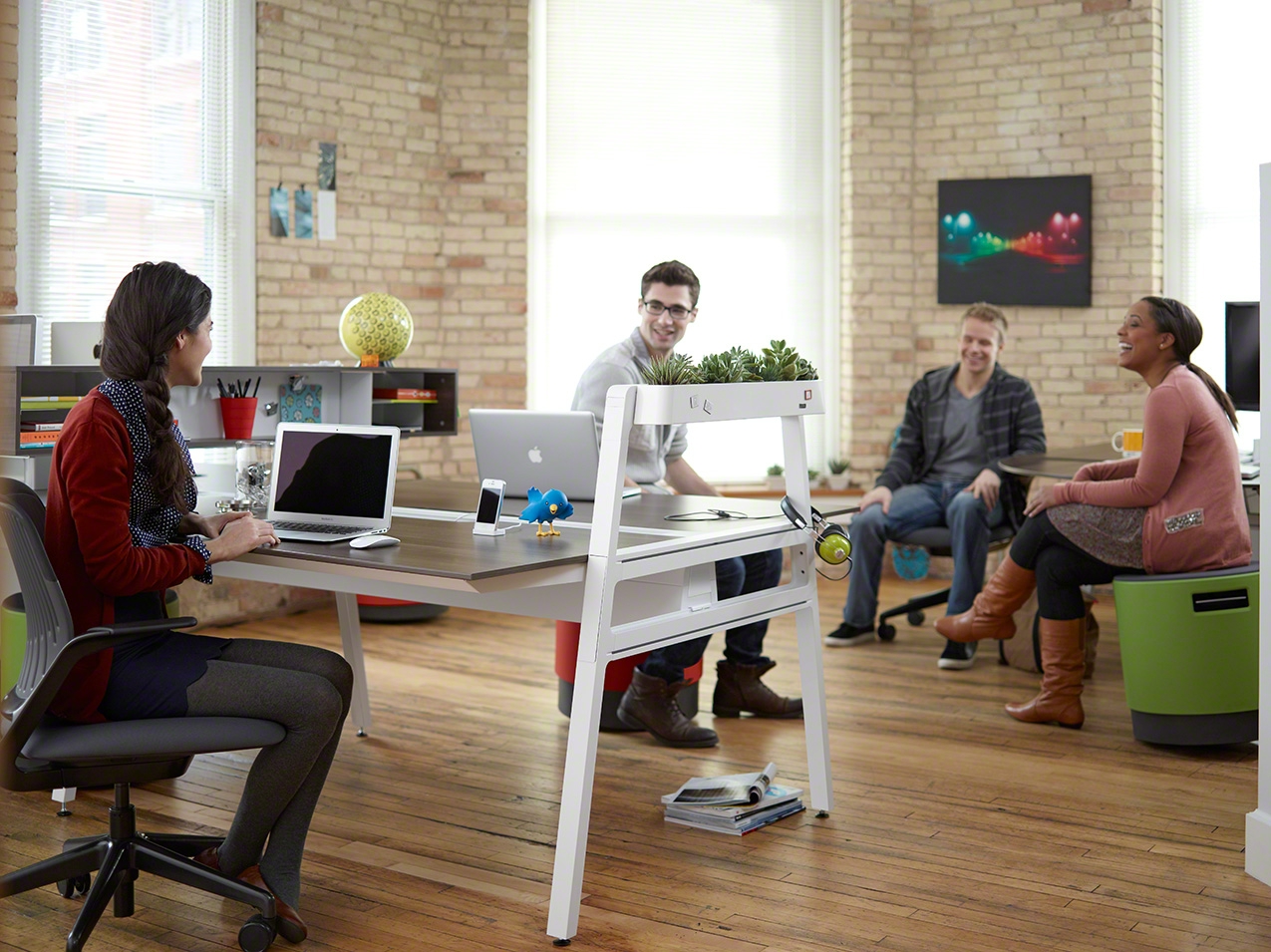
- It’s easier to bring people together to work on projects.
- Project teams members seem more engaged and happier working together.
- It’s faster to talk to coworkers face-to-face than using texting, Slack chat or Skype.
- It’s as natural as working on your notebook computer in a Starbucks coffee shop. (If things get a little noisy, just put on your headphones.)
- It’s less intimidating to meet your boss in an open workplace office — he or she is not hiding behind closed doors.
Not Every Employee is satisfied: Susan Cain Makes a Big Noise about Quiet and Privacy in the Office
You may have picked up in our previous paragraph that we were speaking only about employees who are satisfied working in open workplace office.
Not everyone is happy.
According to Susan Cain, author of the best-selling book Quiet the Power of Introverts in a World That Can’t Stop Talking, the world of workers is divided into two camps — introverts and extroverts.
Susan Cain contends in one of her TED Talks that at least one-third of employees are introverts who must have a quiet, private place to work in order to be productive.
In the book, Cain points out that while extroverts generally welcome the transition to an open workplace, introverts have four primary needs that must be accommodated to make them happy and successful at work:
- Alone time away from highly stimulating workplaces — in order to concentrate and focus.
- Ability to control environmental factors, like noise and light in the workplace, in order to be productive.
- Calming influences, like certain warm colors or natural materials that impart some stimulation without causing sensory overload.
- The privacy that affords introverts a place where they don’t feel they are on stage, e.g. being watched all the time.
Open Workspace Negatives from the Employee Point of View
Research bears out that privacy and noise are the two primary complaints that employees make about open workspaces.
In the What Workers Want 2016 survey, 45% of respondents reported that noise levels were too high in open offices where they worked and 25% said that it harmed their productivity. (This poses a challenge for interior architects who often turn to an acoustic wall and ceiling panels as well as acoustic dividers between desk workstations to address these concerns.)
Many employees find it’s hard to maintain flow, e.g. that especially productive time when we are deeply engaged in a project when we work in an open workplace. This was confirmed in a 2009 study by Finnish researchers who found that many employees had increased concentration problems at work, caused by distractions like phone calls, colleagues’ conversations, people walking by, etc. For those adversely affected by these distractions, the study concluded that employee performance was down and that as a result many of the benefits that open workspaces promised weren’t being fulfilled. (For tips on increasing your productivity, see our article on 15 Ways to Work Smarter, not Harder.)
Another concern held by employees working in open workplace environments is whether the office design concept is a form of managerial control that allows management to ‘spy’ on their work habits throughout the day. As a result, some employees feel more cautious and less likely to collaborate in an open workplace.
Potential Downsides of Open Workplace Designs from the Employer’s Perspective
High on the list of concerns that employers have when implementing open workplace office environments is the potential for employee disengagement.
In other words, employers need to be aware that a large percentage of their workforce may be uncomfortable or downright unhappy in an open workplace environment. The split between who is satisfied or unsatisfied may break down along the lines of introverts and extroverts; it could split along generational lines as well, with older workers feeling more uncomfortable in an open workplace.
Don’t overlook worker diversity issues as well. Most large companies are committed to hiring an increasingly diverse workforce. For example, Microsoft and SAP have been increasing efforts to recruit workers diagnosed on the autism spectrum. Open workplace designs should be reviewed to make sure they can accommodate these new hires as well as other employees with special needs.
What is Your Experience Working in an Open Office?
Are you happy with your current workspace or are you looking to make changes?
We’d like to get your opinion.
In our experience providing furniture for companies at the forefront of the open workplace movement (such as Google, Twitter, and Pinterest) we’ve learned it’s important to strike a balance between working styles – the more choice and flexibility you can provide your employees the better.
So we encourage you to talk to us here at Formaspace. Our design consultants are eager to share their insight and knowledge that comes from planning and manufacturing furniture solutions for every type of need, ranging from Fortune 100 corporate giants to the next hot startup, to offices for individuals working at home.
Give us a call today and create the workplace that’s right for you. You’ll be happy you did.
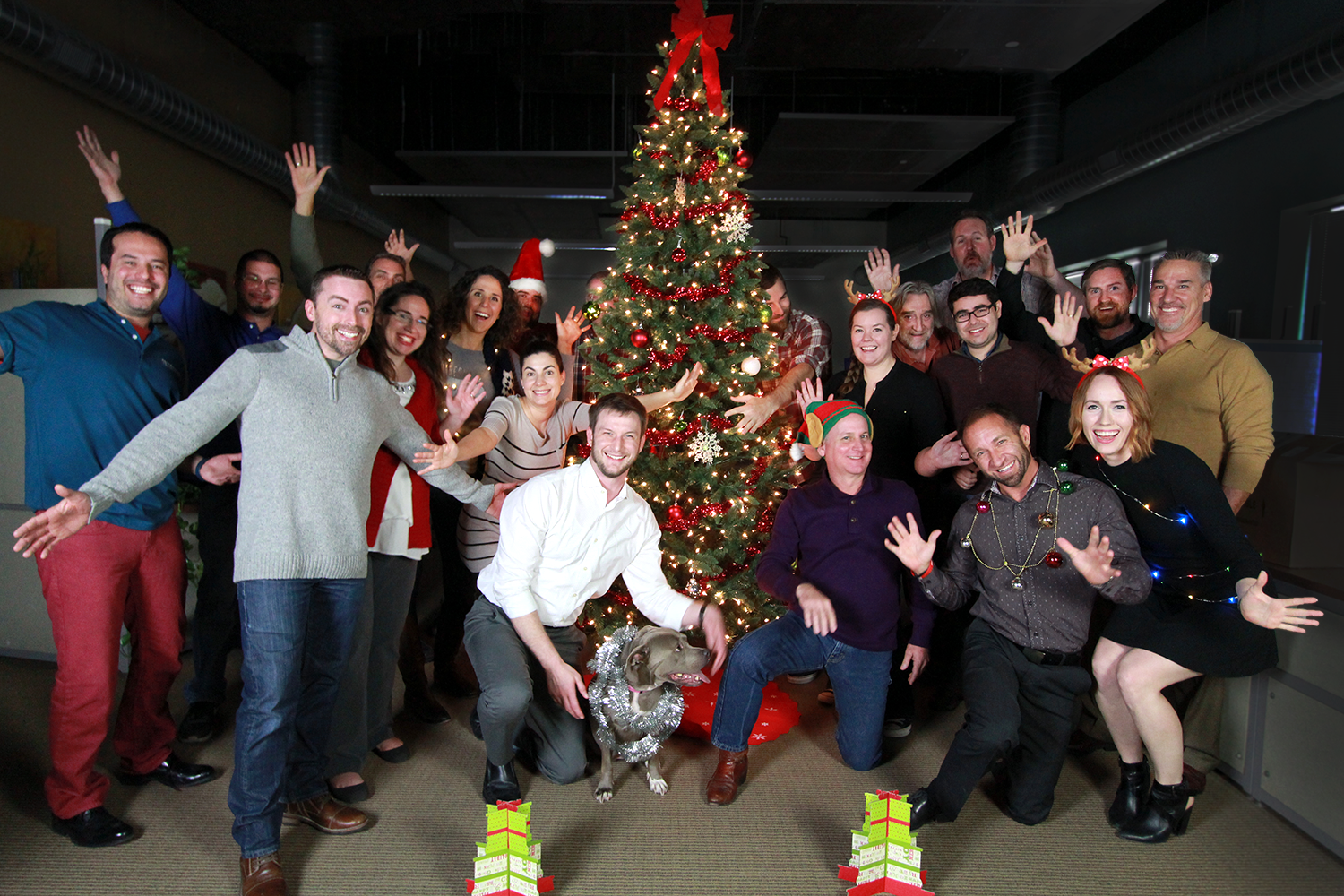
See original post on Formaspace.com
